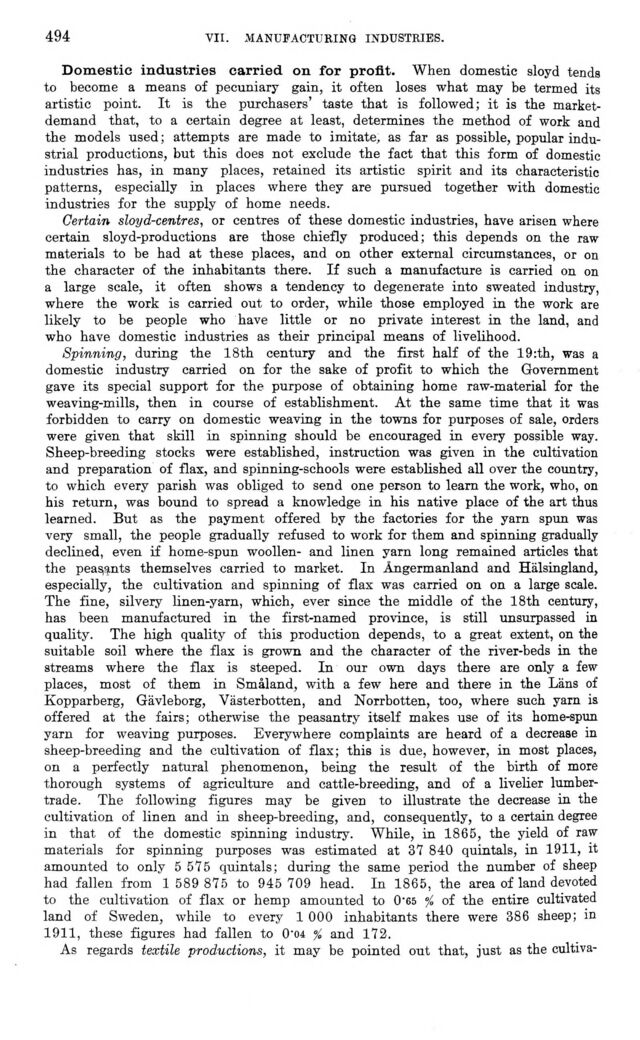
Full resolution (JPEG) - On this page / på denna sida - VII. Manufacturing Industries. Introd. by [G. Sundbärg] K. Åmark - 12. Handicrafts and Domestic Industries. [By A. Raphael] - Domestic Industries. By S. Odén

<< prev. page << föreg. sida << >> nästa sida >> next page >>
Below is the raw OCR text
from the above scanned image.
Do you see an error? Proofread the page now!
Här nedan syns maskintolkade texten från faksimilbilden ovan.
Ser du något fel? Korrekturläs sidan nu!
This page has never been proofread. / Denna sida har aldrig korrekturlästs.
494
vii. manufacturing industries.
Domestic industries carried on for profit. When domestic sloyd tends
to become a means of pecuniary gain, it often loses what may be termed its
artistic point. It is the purchasers’ taste that is followed; it is the
market-demand that, to a certain degree at least, determines the method of work and
the models used; attempts are made to imitate, as far as possible, popular
industrial productions, but this does not exclude the fact that this form of domestic
industries has, in many places, retained its artistic spirit and its characteristic
patterns, especially in places where they are pursued together with domestic
industries for the supply of home needs.
Certain sloyd-centres, or centres of these domestic industries, have arisen where
certain sloyd-productions are those chiefly produced; this depends on the raw
materials to be had at these places, and on other external circumstances, or on
the character of the inhabitants there. If such a manufacture is carried on on
a large scale, it often shows a tendency to degenerate into sweated industry,
where the work is carried out to order, while those employed in the work are
likely to be people who have little or no private interest in the land, and
who have domestic industries as their principal means of livelihood.
Spinning, during the 18th century and the first half of the 19:th, was a
domestic industry carried on for the sake of profit to which the Government
gave its special support for the purpose of obtaining home raw-material for the
weaving-mills, then in course of establishment. At the same time that it was
forbidden to carry on domestic weaving in the towns for purposes of sale, orders
were given that skill in spinning should be encouraged in every possible way.
Sheep-breeding stocks were established, instruction was given in the cultivation
and preparation of flax, and spinning-schools were established all over the country,
to which every parish was obliged to send one person to learn the work, who, on
his return, was bound to spread a knowledge in his native place of the art thus
learned. But as the payment offered by the factories for the yarn spun was
very small, the people gradually refused to work for them and spinning gradually
declined, even if home-spun woollen- and linen yarn long remained articles that
the peasants themselves carried to market. In Ångermanland and Hälsingland,
especially, the cultivation and spinning of flax was carried on on a large scale.
The fine, silvery linen-yarn, which, ever since the middle of the 18th century,
has been manufactured in the first-named province, is still unsurpassed in
quality. The high quality of this production depends, to a great extent, on the
suitable soil where the flax is grown and the character of the river-beds in the
streams where the flax is steeped. In our own days there are only a few
places, most of them in Småland, with a few here and there in the Läns of
Kopparberg, Gävleborg, Västerbotten, and Norrbotten, too, where such yarn is
offered at the fairs; otherwise the peasantry itself makes use of its home-spun
yarn for weaving purposes. Everywhere complaints are heard of a decrease in
sheep-breeding and the cultivation of flax; this is due, however, in most places,
on a perfectly natural phenomenon, being the result of the birth of more
thorough systems of agriculture and cattle-breeding, and of a livelier
lumber-trade. The following figures may be given to illustrate the decrease in the
cultivation of linen and in sheep-breeding, and, consequently, to a certain degree
in that of the domestic spinning industry. While, in 186S, the yield of raw
materials for spinning purposes was estimated at 37 840 quintals, in 1911, it
amounted to only 5 575 quintals; during the same period the number of sheep
had fallen from 1 589 875 to 945 709 head. In 1865, the area of land devoted
to the cultivation of flax or hemp amounted to 0"65 °/0 of the entire cultivated
land of Sweden, while to every 1 000 inhabitants there were 386 sheep; in
1911, these figures had fallen to 0’04 % and 172.
As regards textile productions, it may be pointed out that, just as the cultiva-
<< prev. page << föreg. sida << >> nästa sida >> next page >>